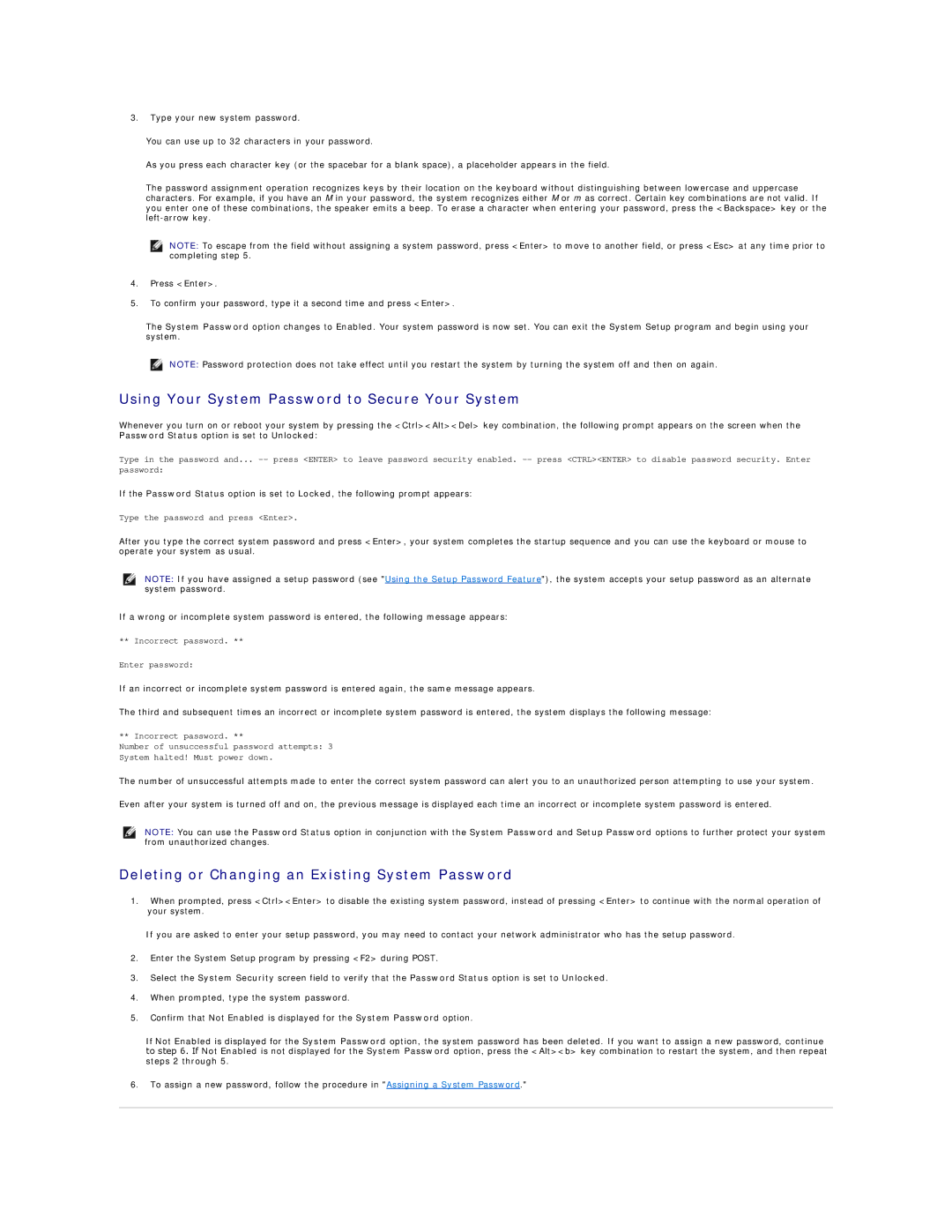
3.Type your new system password.
You can use up to 32 characters in your password.
As you press each character key (or the spacebar for a blank space), a placeholder appears in the field.
The password assignment operation recognizes keys by their location on the keyboard without distinguishing between lowercase and uppercase characters. For example, if you have an M in your password, the system recognizes either M or m as correct. Certain key combinations are not valid. If you enter one of these combinations, the speaker emits a beep. To erase a character when entering your password, press the <Backspace> key or the
NOTE: To escape from the field without assigning a system password, press <Enter> to move to another field, or press <Esc> at any time prior to completing step 5.
4.Press <Enter>.
5.To confirm your password, type it a second time and press <Enter>.
The System Password option changes to Enabled. Your system password is now set. You can exit the System Setup program and begin using your system.
NOTE: Password protection does not take effect until you restart the system by turning the system off and then on again.
Using Your System Password to Secure Your System
Whenever you turn on or reboot your system by pressing the <Ctrl><Alt><Del> key combination, the following prompt appears on the screen when the Password Status option is set to Unlocked:
Type in the password and...
password:
If the Password Status option is set to Locked, the following prompt appears:
Type the password and press <Enter>.
After you type the correct system password and press <Enter>, your system completes the startup sequence and you can use the keyboard or mouse to operate your system as usual.
NOTE: If you have assigned a setup password (see "Using the Setup Password Feature"), the system accepts your setup password as an alternate system password.
If a wrong or incomplete system password is entered, the following message appears:
** Incorrect password. **
Enter password:
If an incorrect or incomplete system password is entered again, the same message appears.
The third and subsequent times an incorrect or incomplete system password is entered, the system displays the following message:
** Incorrect password. **
Number of unsuccessful password attempts: 3
System halted! Must power down.
The number of unsuccessful attempts made to enter the correct system password can alert you to an unauthorized person attempting to use your system.
Even after your system is turned off and on, the previous message is displayed each time an incorrect or incomplete system password is entered.
NOTE: You can use the Password Status option in conjunction with the System Password and Setup Password options to further protect your system from unauthorized changes.
Deleting or Changing an Existing System Password
1.When prompted, press <Ctrl><Enter> to disable the existing system password, instead of pressing <Enter> to continue with the normal operation of your system.
If you are asked to enter your setup password, you may need to contact your network administrator who has the setup password.
2.Enter the System Setup program by pressing <F2> during POST.
3.Select the System Security screen field to verify that the Password Status option is set to Unlocked.
4.When prompted, type the system password.
5.Confirm that Not Enabled is displayed for the System Password option.
If Not Enabled is displayed for the System Password option, the system password has been deleted. If you want to assign a new password, continue to step 6. If Not Enabled is not displayed for the System Password option, press the <Alt><b> key combination to restart the system, and then repeat steps 2 through 5.
6.To assign a new password, follow the procedure in "Assigning a System Password."
